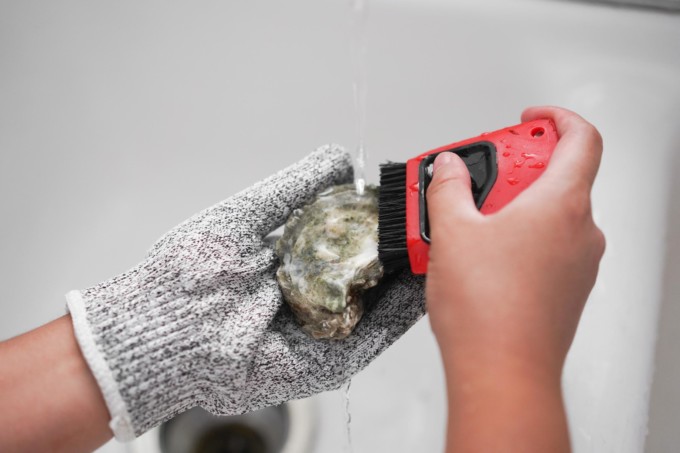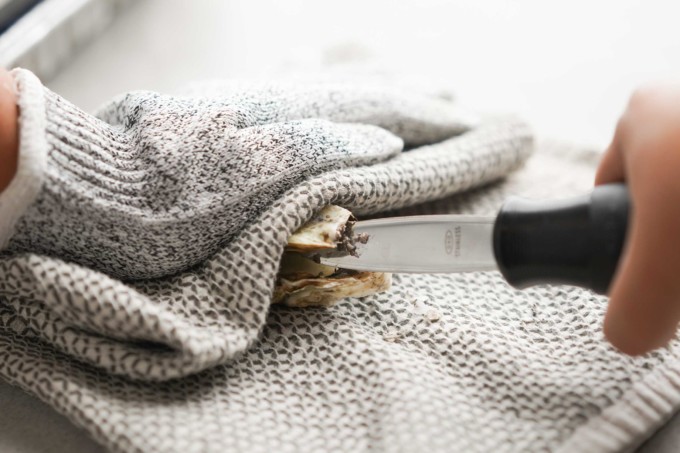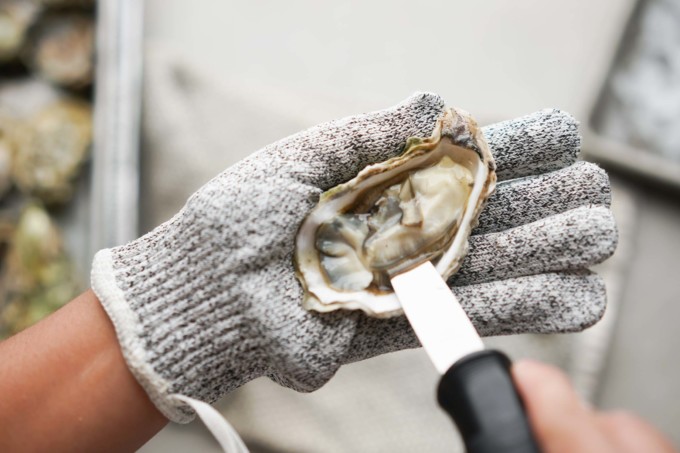Freshly shucked oysters on the half shell over ice always seem super fancy whenever I eat it at a restaurant. After spending way too much money at oyster bars throughout the years, I’ve finally started sourcing and shucking fresh and briny oysters at home. Here are some tips and tricks to guide you on how to choose, prep, shuck, and service oysters on the half shell.

Where to buy oysters & how to select them
When picking oysters, you want to make sure you buy them from a reputable seafood company or source. I like to buy my oysters from stores like Santa Monica Seafood or Santa Barbara Fish Market. I have also found my favorite Kumamoto oysters at Seafood City.

When you are choosing oysters at the grocery store or local seafood company, make sure all the oyster shells are CLOSED (this means they’re still alive). They should also smell like the ocean (no funky smells here).
How to shuck oysters step by step
1. Check for opened oysters
Look at each oyster one by one and check if any of them have open shells. This should look like a gap between the top and bottom shells. When you squeeze the bottom and top shells together, they should stay shut. If you find any open shells, discard them because they shouldn’t be eaten.
2. Scrub them down

Under running water, use a scrubber to remove excess dirt and debris from each oyster. I like to keep scrubbing until the water runs clear. I also like using a brush or scrubber for this job to get all the small crevices on the oyster, especially the hinge where we’ll open the oyster from.
3. Identify parts of the oyster

Hold your oyster with the flat shell facing the sky and the bulbous shell towards the floor. This is the orientation you want your oyster to sit on when you open it. The bulbous bottom holds the oyster in place with some oyster liquor (or juice of the oyster) when you open it.
The hinge is the area where it’s curved on the side of the oyster, and the other side should be a pointed and flattened side. The hinge is where you will wiggle your shucking knife into the oyster and pry it open.
4. Lay it down & cover

Place a folded towel on a flat surface, place the hinge of the oyster facing your dominant hand (or the hand holding the knife), and fold one end of the towel over half of the oyster (keeping the hinge open). The towel helps give you stability when shucking the oyster. I like to also wear cut-resistant gloves on my other hand to prevent any cuts.
5. Slide in, wiggle & turn to open

Take your shucking knife in your dominant hand, while holding the oyster in place with your other hand. Use your knife to slowly (and very carefully) slide into the hinge. This is one of the most difficult parts of shucking an oyster because you can easily break the shell, lose your leverage, or pierce through the oyster and puncture the belly. I like to slide my knife front and back until I can wiggle it and turn the shell slightly open on the right side.
6. Slice the top muscle & remove shell

Before you begin to open the rest of the shell, CLEAN your knife by wiping it on the towel. This will help reduce the amount of shell in your oyster. Pry the shell open a little bit, just enough to slide the knife along the top of the oyster to slice the top adductor muscle. Once it’s severed, remove the top shell and discard it.
7. Cut the bottom muscle

Wipe your knife again and carefully run the knife along the bottom of the oyster to cut off the bottom adductor muscle. This should release the oyster from the shell entirely. Clean off any debris that might be in the oyster shell and serve with your favorite sides or naked!.
When should you not eat oysters?
Oyster connoisseur Rowan Jacobsen has previously stated that the age-old rule of only eating oysters during the “R” months (aka September, October, November, etc.) is not necessarily correct these days due to oyster farming, the creation of refrigerators, and better oyster practices. But he does state that because oysters prepare to spawn during the warmer months, they will taste differently (and some say less flavorful) from May onward.
It’s also important to note to only eat raw oysters from reputable markets and companies that handle fresh seafood. When you’re at a grocery store and want to purchase oysters (or any oyster farm), smell the oysters to make sure they smell like seawater–this means they’re fresh. The oysters should also be completely closed. If there are open oysters that smell funky, don’t touch them.
How do you plate raw oysters?
After you’ve shucked your oysters, make sure to plate them on a crushed-iced lined tray, pan, or plate. I like using quarter half sheet pans because they’re inexpensive, I already have them at home, and the high lips keep the ice inside the pan. Some people also use coarse salt instead of ice to help stabilize the oysters, but I like my oysters chilled.
What to serve with raw oysters
Some of my favorite ways to serve raw oysters on the half-shell are with a classic French mignonette (a sauce made of red wine vinegar, minced shallots, and cracked black pepper), lemon wedges, and Tabasco sauce. For more info on how to serve oysters, visit my post here. I also love serving oysters with other seafood like Viet style grilled clams or grilled whole fish.









